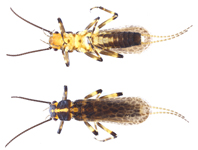Abstract
A new monotypic superfamily, family, genus and species of Hadziida is described from the Brazilian continental shelf. Magnovioidea superfam. nov. Magnovidae fam. nov. and Magnovis gen. nov. are distinguished by the presence of: antenna 1 shorter than the peduncle of antenna 2; maxilliped outer plate falcate; palp, article 4 reduced and left and right mandibles with a well-developed molar that dominates the mandibular area. Eyes are absent. The type-species Magnovis elizabethae sp. nov. has strongly sexually dimorphic males in which gnathopod 2 is larger than gnathopod 1. Magnovidae fam. nov. occurs on the mid-continental shelf.
References
Alves, J., Johnsson, R. & Senna, A.R. (2019) A new species of Ceradocus Costa, 1853 (Senticaudata: Maeridae) from Ceará State, Northeastern Brazil.Zootaxa, 4555 (1), 127–138.
https://doi.org/10.11646/zootaxa.4555.1.11
Alves, J., Neves, E.G. & Johnsson, R. (2018) A review of Quadrimaera Krapp-Schickel Ruffo, 2000 (Amphipoda: Senticaudata) from Brazil. Zootaxa, 4532 (4), 567–593.
https://doi.org/10.11646/zootaxa.4532.4.8
Barnard, J.L. & Karaman, G.S. (1987) Revisions in the classification of Gammaridean Amphipoda (Crustacea). III. Proceedings of the Biological Society of Washington, 100 (4), 856–875.
Barnard, K.H. (1930) Amphipoda. Discovery Reports, 5, 1–326.
https://doi.org/10.5962/bhl.part.27664
Boutin, C.& Messouli, M. (1988) Metacrangonyx gineti n. sp. d’une source du Haut-Atlas Marocain et la famille des Metacrangonyctidae n. fam .(Crustacés Amphipodes stygobies). Vie et Milieu, 38 (1), 67–84.
Bousfield, E.L. (1973) Shallow-water gammaridean Amphipoda of New England. Cornell University Press, Ithaca, New York, 312 pp.
Bousfield, E.L. (1979) The amphipod superfamily Gammaroidea in the northeastern Pacific region: systematics and distribution ecology. Bulletin of the Biological Society of Washington, 3, 297–359.
Karaman, S.L. (1943) Die unterirdischen Amphipoden Südserbiens. Srpska Akademia Nauka, Posebna Izdana, 135 (Prirodn’achki i Mathematichki Spisi), 34 (4), 161–312.
Krapp-Schickel, T. (2008) What has happened with the Maera-clade during the last decades? Bollettino del Museo Civico di Storia Naturale di Verona, 32, 3–32.
Latreille, P.A. (1816) Amphipoda. In: Nouveau Dictionaire d’histoire naturelle, appliquée aux Arts, à l’Agriculture, à l’Économie rurale et domestique, à la Médecine, etc. Par une société de Naturalistes et d’Agriculteurs. Vol. 1. 2nd Edition. Deterville, Paris, pp. 467–469.
Lowry, J.K. & Myers, A.A. (2012) New, mainly southern hemisphere, freshwater families of Amphipoda (Crustacea), together with a description of the first freshwater calliopiid, Lutriwita bradburyi gen. nov. et sp. nov. Zootaxa, 3499 (1), 27–45.
https://doi.org/10.11646/zootaxa.3499.1.2
Lowry, J.K. & Myers, A.A. (2013) A phylogeny and classification of the Senticaudata subord. nov. (Crustacea: Amphipoda). Zootaxa, 3610 (1), 1–80.
https://doi.org/10.11646/zootaxa.3610.1.1
Lowry, J.K. & Myers, A.A. (2017) A phylogeny and classification of the Amphipoda with the establishment of the new order Ingolfiellida (Crustacea: Peracarida) Zootaxa, 4265 (1), 1–89.
https://doi.org/10.11646/zootaxa.4265.1.1
Poore, A.G., & Lowry, J.K. (1997) New ampithoid amphipods from Port Jackson, New South Wales, Australia (Crustacea: Amphipoda: Ampithoidae). Invertebrate Systematics, 11 (6), 897–941.
https://doi.org/10.1071/IT95045
Sars, G.O. (1895) An account of the Crustacea of Norway with short descriptions and figures of all the species. Vol.1. Amphipoda. ALB Cammermeyers Forlag, Christiania and Copenhagen, 711 pp.
https://doi.org/10.5962/bhl.title.1164
Serejo, C.S. & Siqueira, S.G.L. (2018) Catalogue of the Order Amphipoda from Brazil (Crustacea, Peracarida): Suborders Amphilochidea, Senticaudata and Order Ingolfiellida. Zootaxa, 4431 (1), 1–139.
https://doi.org/10.11646/zootaxa.4431.1.1
Shoemaker, C.R. (1930) The Amphipoda of the Cheticamp Expedition of 1917. Contributions to Canadian Biology and Fisheries, New Series, 5 (10), 221–359.
https://doi.org/10.1139/f30-010
Stebbing, T.R.R. (1906) Amphipoda I. Gammaridea. Das Tierreich, 21, 1–806.
Thomas, J.D. & Barnard, J.L. (1986) New genera and species of the Megaluropus group (Amphipoda, Megaluropidae) from American seas. Bulletin of Marine Science, 38 (3), 442–476.
Udekem d’Acoz, C. (2010) Contribution to the knowledge of European Liljeborgiidae (Crustacea, Amphipoda), with considerations on the family and its affinities. In: Bulletin van het Koninklijk Belgisch Instituut voor Natuurwetenschappen. Entomologie et Biologie. Vol. 80. Koninklijk Belgisch Instituut voor Natuurwetenschappen, Bruxelles, pp. 127–259.
Watling, L. (1989) A classification system for crustacean setae based on the homology concept. Crustacean issues, 6, 15–26.


